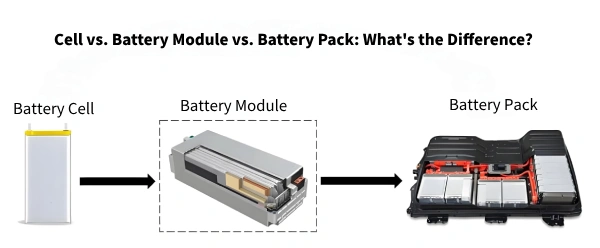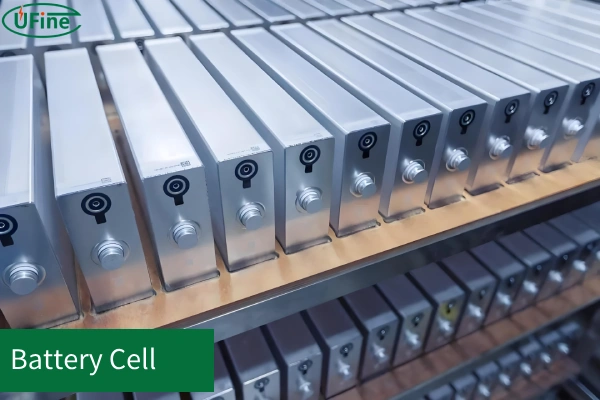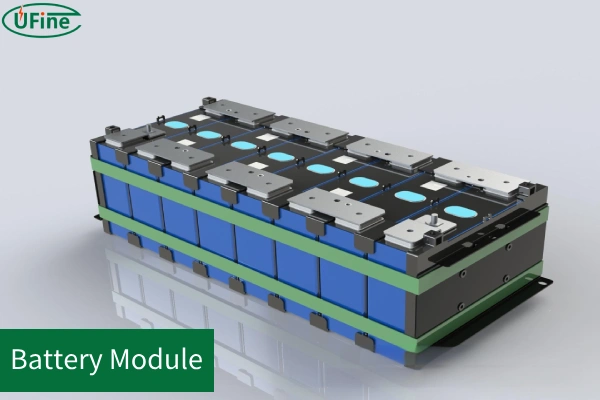Have you ever wondered what powers electric vehicles, renewable energy systems, and many modern gadgets? It all starts with a battery module. These modules are the building blocks of larger battery systems, providing the necessary energy storage and management for various applications. In this article, we’ll dive deep into what a battery module is, its components, how it differs from other battery configurations, and the steps to assemble a module and a pack. So, let’s get started!
Part 1. What is a battery module?
A battery module is essentially a collection of battery cells organized in a specific arrangement to work together as a single unit. Think of it as a middle layer in the hierarchy of battery systems. While a single battery cell can store and release energy, combining multiple cells into a module increases the overall capacity and power output. This modular approach allows for scalable energy solutions, making it easier to build larger and more powerful battery packs.
Why Battery Modules are Important
Battery modules are crucial because they offer a balance between manageability and capacity. Individual cells are too small to power large devices, while entire battery packs are cumbersome to handle and maintain. Modules, however, strike the right balance, making it easier to design, assemble, and maintain complex energy storage systems.
Part 2. Battery module composition
A battery module comprises several key components, each vital in its functionality and safety. Let’s break down these components and their functions:
Battery Module Key Components:
1. Battery Cells:
The module’s heart consists of individual units that store and release electrical energy. These are the primary energy storage units. They come in various chemistries, each with its advantages and disadvantages.
Battery Management System (BMS): A critical component that monitors and manages the health and performance of the battery cells.
The BMS is like the brain of the module. It ensures that the cells charge and discharge safely, preventing overcharging, over-discharging, and short-circuiting issues.
2. Cooling System:
Ensures that the cells remain at an optimal temperature, preventing overheating.
This system helps dissipate the heat generated during operation. Proper cooling is essential for maintaining the efficiency and longevity of the cells.
3. Electrical Connections:
Wires and connectors that link the cells together and to external circuits. These include busbars and connectors that ensure reliable electrical connections between cells and the external load.
4. Enclosure:
A protective casing that shields the internal components from physical damage and environmental factors.
The enclosure provides structural integrity and protects the cells and other components from external shocks, dust, moisture, and other environmental hazards.
Part 3. Cell vs. battery module vs. battery pack: what’s the difference?
Understanding the differences between a battery cell, module, and pack is crucial for anyone involved in energy storage solutions. These terms are often used interchangeably, but they refer to different levels of complexity and functionality.
1. Battery Cell
The smallest and most basic unit, capable of storing and releasing energy.
These are the foundational units of any battery system. They are typically small and have limited capacity. However, they are versatile and can be used in various applications, from smartphones to small electronic devices.
2. Battery Module
A group of cells combined into a unit to provide more energy and capacity.
By combining multiple cells, a battery module offers greater energy capacity and output. Modules are designed to be manageable in size and complexity, making them easier to integrate into various applications, such as electric vehicles and renewable energy systems. The inclusion of a BMS and cooling system ensures safe and efficient operation.
3. Battery Pack
Multiple modules are assembled to create a more powerful energy storage system.
A battery pack is an assembly of multiple battery modules. This configuration provides a significant boost in energy capacity and power output, suitable for large-scale applications such as electric vehicles, grid storage, and backup power systems. Battery packs are complex and require advanced management and cooling systems to operate safely and efficiently.
Part 4. How to make a battery module from battery cells?
Creating a battery module from individual cells involves a series of meticulous steps. Here’s a detailed guide on how to do it:
Step-by-Step Guide
1. Gather Materials:
- Battery cells
- Battery Management System (BMS)
- Electrical connectors (busbars, wires)
- Cooling components (fans, heat sinks)
- Protective enclosure (plastic or metal casing)
- Tools (soldering iron, multimeter, insulation materials)
2. Test Cells:
- Check the voltage and capacity of each cell to ensure they are within acceptable ranges.
- Match cells with similar capacities to maintain balance within the module.
3. Arrange Cells:
- Design the layout based on the desired configuration (series, parallel, or a combination).
- Place the cells in a holder or frame to keep them organized and secure.
4. Connect Cells:
- Solder or weld the electrical connectors to link the cells according to the chosen configuration.
- Ensure connections are secure and well-insulated to prevent short circuits.
5. Install BMS:
- Attach the BMS to the module, connecting its wires to the appropriate cell terminals.
- The BMS will monitor and manage the cells’ voltage, temperature, and overall health.
6. Add Cooling:
- Implement a cooling system, such as heat sinks or fans, to manage the heat generated during operation.
- Ensure the cooling components are securely attached and positioned for optimal airflow.
7. Enclose the Module:
- Place the assembled module into a protective enclosure.
- Ensure the enclosure is sturdy and adequately protects against physical damage and environmental factors.
8. Test the Module:
- Perform a series of tests to verify the module’s performance and safety.
- Check for proper voltage output, temperature regulation, and overall functionality.
Part 5. How does a battery module make a battery pack?
Once you have a battery module, assemble it into a battery pack. Here’s a step-by-step process to guide you:
Step-by-Step Guide
1. Prepare Modules:
Ensure all battery modules are fully assembled and tested for performance and safety.
2. Design Layout:
- Plan the arrangement of the modules within the pack. Consider space, cooling, and wiring requirements.
- Use a design that balances the load and maximizes efficiency.
3. Connect Modules:
- Use electrical connectors to link the modules, following the desired series or parallel configuration.
- Ensure connections are secure and insulated to prevent electrical hazards.
4. Install BMS:
- Attach a comprehensive BMS to manage the entire battery pack.
- The BMS will monitor the performance of each module and ensure balanced charging and discharging.
5. Add Cooling System:
- Implement an advanced cooling system to maintain optimal temperatures across the pack.
- Use fans, heat sinks, or liquid cooling systems to manage heat dissipation.
6. Enclose the Pack:
- Secure the assembled modules in a robust enclosure. The enclosure should be durable and protect against physical impacts, dust, and moisture.
- Ensure the enclosure allows for adequate ventilation or integration of the cooling system.
7. Perform Final Tests:
- Conduct thorough testing of the battery pack to ensure it operates safely and efficiently.
- Check for proper voltage output, temperature regulation, and overall functionality.
- Perform stress tests to verify the pack’s performance under various conditions.
Part 6. Conclusion
-
What are the advantages of using a battery module in a system?
Battery modules offer several benefits, including flexibility in design, scalability, and ease of maintenance. They allow for customized configurations in terms of voltage and capacity, making them ideal for specific power needs. Battery modules also simplify replacement and repair because individual modules can be swapped out without replacing the entire battery system. -
How do battery modules differ from individual cells?
Battery modules are made up of multiple individual cells, whereas a cell is the basic unit of a battery that stores and releases electrical energy. A module is a larger, more robust component that integrates several cells to provide higher power output and capacity. Modules include components like Battery Management Systems (BMS) that manage the charging, discharging, and safety of the battery cells. -
How do you know if a battery module is failing?
Signs that a battery module may be failing include reduced performance (shorter battery life or slower charging), swelling, overheating, visible damage, or an error message from the Battery Management System (BMS). If a module is experiencing these issues, it’s important to replace or repair it to prevent further damage to the entire system. -
Can you replace individual cells in a battery module?
In most cases, battery modules are designed to be replaced as a whole unit. While it’s possible to replace individual cells in some modules, it’s not recommended unless you have the technical expertise. Replacing a single cell can disrupt the module’s balance and affect overall performance. It’s often more efficient and safer to replace the entire module if issues arise. -
Are battery modules safe to use in high-temperature environments?
Battery modules are generally designed to function within a specific temperature range. Exposure to temperatures that are too high can cause overheating, reduced efficiency, and potential damage to the cells. Some high-performance modules include built-in cooling systems to regulate temperature, but it’s always essential to use them within the manufacturer’s recommended temperature range.
Related Tags:
More Articles

How to Choose the Best Floor Scrubber Battery for Commercial Cleaning?
Selecting the ideal floor scrubber battery ensures a long runtime, rapid charging, and minimal maintenance for efficient commercial cleaning operations.
Battery for Blower vs Battery for Leaf Vacuum: Which One Should You Choose?
Battery for blower vs leaf vacuum—learn the key differences in power, fit, and runtime to choose the right battery for your outdoor tool needs.
How to Choose the Right Battery for Blower?
Choosing the right blower battery? Consider voltage, capacity, chemistry & usage. This guide helps match the best battery for peak performance.
How to Choose the Best Insulated Battery Box for Lithium Batteries?
Choosing the Best Insulated Battery Box for Lithium Batteries? Discover key factors such as size, material, and safety for optimal protection and performance.
7 Critical Elements on a Lithium Battery Shipping Label
What must be on a lithium battery shipping label? Learn 7 key elements to ensure safety, legal compliance, and correct handling across all transport modes.






